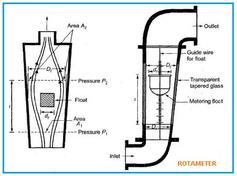Thermal Mass Flowmeters: Advantages and Disadvantages
Advertisement
This article explores the pros and cons of thermal mass flowmeters, detailing their benefits and drawbacks.
What is a Thermal Mass Flowmeter?
Introduction:
Thermal mass flowmeters are instruments that measure the mass flow rate of a fluid by assessing heat transfer. They operate on the principle of measuring temperature differences.
- These meters work by gauging heat convection from a heated surface to the flowing fluid.
- There are two main types:
- Thermal Dispersion (or Immersible) Type: Heat is transferred to the boundary layer of the fluid as it flows over a heated surface.
- Capillary Tube Type: Heat is transferred to the bulk of the fluid as it passes through a small, heated capillary tube.

Figure 1 depicts a typical thermal mass flowmeter. As shown, two Resistance Temperature Detector (RTD) sensors are utilized. One sensor is self-heated (the “flow sensor”), while the other (the “reference sensor”) measures the gas temperature. These sensors can be installed as part of a probe in an insertion style or directly within the pipe section in an in-line configuration.
The electrical power required to maintain a constant temperature difference is directly proportional to the gas mass flow rate.
Benefits (Advantages) of Thermal Mass Flowmeters
Here are the key advantages of using thermal mass flowmeters:
- Direct Gas Mass Flow Measurement: They directly measure the mass flow of gases.
- Independence from Fluid Properties: Operation is unaffected by changes in pressure, density, and viscosity.
- High Accuracy: These meters offer a high degree of measurement accuracy.
- Low Pressure Drop: They cause very little pressure loss in the system.
- No Compensation Needed: Pressure and temperature compensation is not required for accurate readings.
- Wide Measurement Range: They have a large span, allowing for measurements across a broad range of flow rates.
- No Moving Parts: Their design has no moving parts, which leads to less maintenance and greater reliability.
- Rugged Construction: Thermal mass flowmeters are typically robust and durable.
- Fast Response Time: They respond quickly to changes in flow rates.
- Easy Sterilization: They can be easily sterilized, making them suitable for certain applications.
Drawbacks (Disadvantages) of Thermal Mass Flowmeters
Here are the limitations and disadvantages of using thermal mass flowmeters:
- Gas Measurement Only: They are primarily used for gas measurements and not liquids.
- Requires Inlet and Outlet Sections: Proper installation requires specific inlet and outlet straight pipe sections to ensure accurate readings.
- Sensitivity to Condensation and Buildup: Condensation of moisture in saturated gases on the temperature detector can cause the meter to read low. Additionally, coating or material buildup on the sensor can inhibit heat transfer, also resulting in low readings.
- Error Due to Gas Composition: Variations in specific heat due to changes in the gas’s composition can introduce errors in meter readings.
Advertisement
 T&M
T&M 






